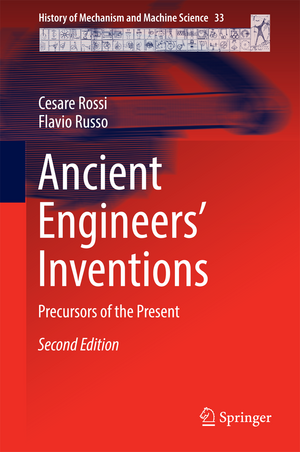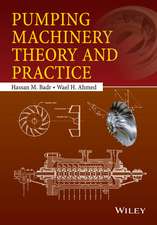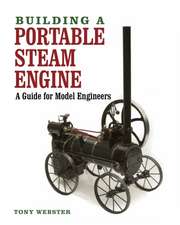Ancient Engineers' Inventions: Precursors of the Present: History of Mechanism and Machine Science, cartea 33
Autor Cesare Rossi, Flavio Russoen Limba Engleză Hardback – 7 sep 2016
Most of the inventions presented in the first four parts of this book were conceived up to the late Roman Empire and may be considered as milestones, each in their respective field. The fifth part concentrates on more recent centuries. The sixth part deals with some building construction techniques.
Generally, for each of the presented inventions, three elements of research and reference are provided: written documents (the classics), iconic references (coins, bas-reliefs, etc.) and archaeological findings.
The authors did not write this book for engineers only; hence they describe allthe devices without assuming wide technical knowledge. The authors’ main aim is to try to communicate their enthusiasm for the inventions and the inventors of the past and to contribute to the fascinating study of the History of Engineering.
This second edition includes new topics and chapters that are of special interest to engineers.
| Toate formatele și edițiile | Preț | Express |
|---|---|---|
| Paperback (1) | 794.86 lei 38-44 zile | |
| Springer International Publishing – 22 apr 2018 | 794.86 lei 38-44 zile | |
| Hardback (1) | 1018.55 lei 3-5 săpt. | |
| Springer International Publishing – 7 sep 2016 | 1018.55 lei 3-5 săpt. |
Din seria History of Mechanism and Machine Science
- 15%
 Preț: 647.40 lei
Preț: 647.40 lei - 15%
 Preț: 666.73 lei
Preț: 666.73 lei - 20%
 Preț: 752.94 lei
Preț: 752.94 lei - 18%
 Preț: 1002.61 lei
Preț: 1002.61 lei - 18%
 Preț: 950.52 lei
Preț: 950.52 lei - 18%
 Preț: 735.84 lei
Preț: 735.84 lei - 15%
 Preț: 649.54 lei
Preț: 649.54 lei - 15%
 Preț: 637.46 lei
Preț: 637.46 lei - 18%
 Preț: 1227.67 lei
Preț: 1227.67 lei - 15%
 Preț: 633.35 lei
Preț: 633.35 lei -
 Preț: 384.31 lei
Preț: 384.31 lei - 15%
 Preț: 655.92 lei
Preț: 655.92 lei -
 Preț: 389.70 lei
Preț: 389.70 lei - 15%
 Preț: 644.82 lei
Preț: 644.82 lei - 18%
 Preț: 954.45 lei
Preț: 954.45 lei -
 Preț: 442.13 lei
Preț: 442.13 lei - 20%
 Preț: 576.88 lei
Preț: 576.88 lei - 18%
 Preț: 944.19 lei
Preț: 944.19 lei - 24%
 Preț: 788.01 lei
Preț: 788.01 lei - 15%
 Preț: 647.73 lei
Preț: 647.73 lei - 15%
 Preț: 645.28 lei
Preț: 645.28 lei - 18%
 Preț: 963.60 lei
Preț: 963.60 lei - 18%
 Preț: 967.08 lei
Preț: 967.08 lei - 15%
 Preț: 645.28 lei
Preț: 645.28 lei -
 Preț: 399.29 lei
Preț: 399.29 lei - 15%
 Preț: 644.82 lei
Preț: 644.82 lei - 20%
 Preț: 594.05 lei
Preț: 594.05 lei - 15%
 Preț: 645.28 lei
Preț: 645.28 lei
Preț: 1018.55 lei
Preț vechi: 1242.14 lei
-18% Nou
Puncte Express: 1528
Preț estimativ în valută:
194.92€ • 211.66$ • 163.73£
194.92€ • 211.66$ • 163.73£
Carte disponibilă
Livrare economică 01-15 aprilie
Preluare comenzi: 021 569.72.76
Specificații
ISBN-13: 9783319444758
ISBN-10: 3319444751
Pagini: 457
Ilustrații: XVII, 420 p. 300 illus., 116 illus. in color.
Dimensiuni: 155 x 235 x 28 mm
Greutate: 0.98 kg
Ediția:2nd ed. 2017
Editura: Springer International Publishing
Colecția Springer
Seria History of Mechanism and Machine Science
Locul publicării:Cham, Switzerland
ISBN-10: 3319444751
Pagini: 457
Ilustrații: XVII, 420 p. 300 illus., 116 illus. in color.
Dimensiuni: 155 x 235 x 28 mm
Greutate: 0.98 kg
Ediția:2nd ed. 2017
Editura: Springer International Publishing
Colecția Springer
Seria History of Mechanism and Machine Science
Locul publicării:Cham, Switzerland
Cuprins
Premise: Representing and Measuring the Environment.- A premise: it all started with a drawing.- I.1 Elevations, Plan and Sections.- I.2 Protohistoric Drafting machine for the clay tablets engraving.- I.3 Examples of planimetries from the IV millennium B.C. to the I century A.D..- I.4 Ancient Units.- 1. Measuring Mass.- Introduction.- 1.1 The balance scale.- 1.2 The steelyard balance.- Observations.- 2 Measuring Distance and Slope.- Introduction.- 2.1 Jacob’s staff.- 2.2 Range finders.- 2.3 The Astrolabe.- 2.4 The dioptre by Heron.- 2.5 The ancient odometers.- Observations.- Measuring a building height by an astrolabe.- Measuring the distances by the groma and by the surveyor’s cross.- 3 Measuring Time.- Introduction.- 3.1 The sundial.- 3.2 Water clocks.- Observations.- 4 Orientation.- Introduction.- 4.1 The Sundial Compass.- 4.2 The Chinese South-Pointing Chariot Sundial Compass.- 4.3 The Windrose and the Magnetic Compass.- 5 Ancient Computation Devices.- Introduction.- 5.1 The Abacus.- 5.2 The Mesolabio.- 5.3 The Mechanism of Antikitera.- Observations.- 6 The Natural Energy Used In Antiquity.- Introduction.- 6.1 Energy from man.- 6.2 Energy from animals.- 6.3 The capstan.- 6.4 The treadwheel.- 6.5 Rough evaluation of the power from a wind motor.- 6.6 Rough evaluation of the power from a waterwheel.- 7 Wind Motors.- Introduction.- 7.1 The wind mills.- 7.2 Wings on the sea: the sails.- 7.3.3 The Flettner rotor.- Observations.- 8 Hydraulic Motors.- Introduction.- 8.1 Water wheels with vertical axis.- 8.2 Water wheels with horizontal axis.- 8.3 The floating mill.- 8.4 Water wheels in the Middle Ages and the Renaissance.- Observations.- 9 Refrigeration and Heating.- 9.1 Air Cooling with Wind Towers.- 9.2 The production of ice.- 9.3 Nero’s Sherbet.- 9.3 Wheat Pits.- 9.4 Heating and Thermal Baths.- 9.5 Energy Saving: the Sun Chimney Heating and Thermal Baths.- 10 The Production Of Water.- 10.1 The Air Well.- 10.2 The DewBasin.- 10.3 The Qanat.- 10.4 Distillation.- 11 Lifting Water.- Introduction.- 11.1 The early devices.- 11.2 The Archimedes’ screw.- 11.3 Norias.- 11.4 Pumps.- Observations.- 12 Adduction and Distribution of Water.- Introduction.- 12.1 Open ducts.- 12.2 Penstocks.- 12.3 The great cisterns.- 12.4 Water distribution systems.- 12.5 Pipes.- 12.6 Valves.- 12.7 Hydraulic mining.- Observations.- 13 Underwater Activities.- Introduction.- 13.1 Scuba divers.- 13.2 Diving bell.- 14 Transports.- Introduction.- 14.1 Roman charts.- 14.2 Railed cargo.- 14.3 The rails of Pompei.- 14.4 Ancient self-propelled vehicles.- 14.5 Early ball bearings.- 14.6 Transport on water.- 14.7 Cableways.- 14.10 The dawn of the flight in the antiquity.- Observations.- 15 Telecommunications.- Introduction.- 15.1 Acoustic.- 15.2 Carrier pigeons.- 15.3 Optical telecommunication systems.- 15.4 Lighthouses.- 15.5 The water telegraph.- Observations.- 16 Medicine and Health.- Introduction.- 16.1 Medical Assistance provided to Legionnaires.- 16.2 Reconstructive Plastic Surgery.- 16.3 Early Penicillin.- 16.4 The Beginning of Biological Warfare.- 17 Secondary Motors.- Introduction.- 17.1 Cranes and tackle.- 17.2 Gravity driven elevators.- 17.3 Siege towers.- 17.4 The trebuchet.- 17.5 Flexion elastic motors.- 17.6 Torsion elastic motors.- 17.7 Throwing machines operated by torsion motors.- 17.8 Mechanics of the throwing machines.- 17.9 Pneumatic motors.- 17.10 Small spring motors.- 17.11 Ancient steam engines.- Observations.- 18 Spinnind and Weaving.- Introduction.- 18.1 The dawn of spinning and weaving.- 18.2 The spinning wheel.- 18.3 The mechanical spinning.- 18.4 The automatic weaving.- Observations.- 19 Some Applications of Fire.- Introduction.- 19.1 Fire ignition.- 19.1.2 Optical flints.- 19.2 Marine fire – the Roman candle.- 19.3 Wind lanterns.- 19.4 Fire for warming.- 19.5 Fire for warfare.- 19.6 The protection from fire: asbestos.- 20 Automata (Towards automation androbots).- Introduction.- 20.1 The Hellenistic Age.- 20.2 The Middle Ages.- 20.3 The Renaissance.- 20.4 The XVIII Century.- 20.5 The XIX Century.- 20.6 Automata of the Far East.- 20.7 Between the two millenniums.- Observations.- 21 Some Ancient Building Techniques.- Introduction.- 21.1 Stone buildings.- 21.2 Concrete Buildings.- 21.3 Considerations on the polygonal work.- 21.4 Earthquake-resistant buildings with wooden ribs.- 21.5 Seismic isolators.- 21.6 Consideration on ancient concrete.- Subject Index.
Recenzii
“The book is well illustrated with both black-and-white and color drawings and photographs. … this book will appeal to individuals interested in the histories of both mechanical engineering and civil engineering. It is recommended to those who are also interested in ancient Greek and Roman technologies. Summing Up: Recommended. Upper-division undergraduates and above; faculty and professionals.” (A. M. Strauss, Choice, Vol. 54 (9), May, 2017)
Notă biografică
Cesare Rossi received the Mechanical Engineer Degree cum Laude at the University of Napoli - "Federico II" in 1979; in the same year his doctoral thesis received the Asmeccanica (Italian Mechanical Engineering Association) award.
He participated in many International Conferences, often with invited lectures and as Chairman. His research activities where carried on mainly in the topics of Tribology, Rotor Dynamics, Mechanical Vibrations, Chaotic Motions of Mechanical Systems, Robot Mechanics, Video Applications for Robotics. Since several years he is interested in studies and researches on the History of Engineering and presently he cooperates with researchers (also on the field) mainly in which the Classic Age is concerned. He is a member of the A.I.S.I (Italian Society for the History of Engineering).
Flavio Russo holds a degree in Mining Engineering from the University of Rome.
Has been studying military architecture and military history in general for the past thirty years, focusing especially on military technology. For ten years he was member of Scientific Councils of the Italian Institute for the Castles and of National Committee for Studies of Fortified Architectures at the Italian Cultural Heritage Department.
Currently he is working at the reconstruction of a roman water wheel, starting from archaeological finds.
He participated in many International Conferences, often with invited lectures and as Chairman. His research activities where carried on mainly in the topics of Tribology, Rotor Dynamics, Mechanical Vibrations, Chaotic Motions of Mechanical Systems, Robot Mechanics, Video Applications for Robotics. Since several years he is interested in studies and researches on the History of Engineering and presently he cooperates with researchers (also on the field) mainly in which the Classic Age is concerned. He is a member of the A.I.S.I (Italian Society for the History of Engineering).
Flavio Russo holds a degree in Mining Engineering from the University of Rome.
Has been studying military architecture and military history in general for the past thirty years, focusing especially on military technology. For ten years he was member of Scientific Councils of the Italian Institute for the Castles and of National Committee for Studies of Fortified Architectures at the Italian Cultural Heritage Department.
Currently he is working at the reconstruction of a roman water wheel, starting from archaeological finds.
Textul de pe ultima copertă
This book describes the inventions and designs of ancient engineers who are the precursors of the present. The period ranges mainly from 300 B.C. to 1600 A.D. with several exceptions. Many of the oldest inventions are documented by archaeological finds, often very little known, mainly from Pompeii, Herculaneum and Stabiae and reveal a surprising modernity in their conception.
Most of the inventions presented in the first four parts of the book were conceived up to the late Roman Empire and may be considered as milestones, each in their respective field. The fifth part concentrates on more recent centuries. The sixth part deals with some building construction techniques.
Generally, for each of the presented inventions, three elements of research and reference are provided: written documents (the classics), iconic references (coins, bas-reliefs, etc.) and archaeological findings.
The authors did not write this book for engineers only; hence they describe all thedevices without assuming wide technical knowledge. The authors’ main aim is to try to communicate their enthusiasm for the inventions and the inventors of the past and to contribute to the fascinating study of the History of Engineering.
This second edition includes new topics and chapters that are of special interest to engineers.
Most of the inventions presented in the first four parts of the book were conceived up to the late Roman Empire and may be considered as milestones, each in their respective field. The fifth part concentrates on more recent centuries. The sixth part deals with some building construction techniques.
Generally, for each of the presented inventions, three elements of research and reference are provided: written documents (the classics), iconic references (coins, bas-reliefs, etc.) and archaeological findings.
The authors did not write this book for engineers only; hence they describe all thedevices without assuming wide technical knowledge. The authors’ main aim is to try to communicate their enthusiasm for the inventions and the inventors of the past and to contribute to the fascinating study of the History of Engineering.
This second edition includes new topics and chapters that are of special interest to engineers.
Caracteristici
Describes the technical aspects and historical developments of mechanism design in antiquity Reconstructs lesser known inventions based on the classics, iconic references, and archaeological finds from (mainly but not only) Pompei, Ercolano and Stabia Augmented for this second edition with new material Includes supplementary material: sn.pub/extras












